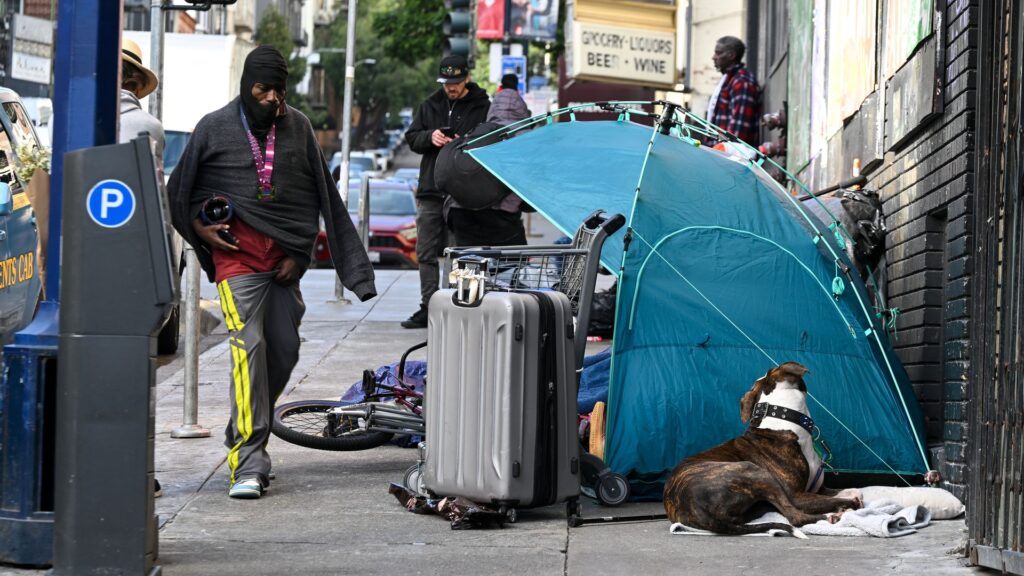California Gov. Gavin Newsom is pushing for cities in his state to ban homeless encampments, which have become a common sight in parks, sidewalks and other public spaces across the Golden State. Newsom announced Monday that he has drafted a template for local governments to adopt ordinances to shut down existing encampments and ban new ones.
At the same time, Newsom – a potential Democratic presidential candidate in 2028 – says he’s also allocating $3.3 billion in voter-approved funding to expand treatment and housing for the homeless.
What is Newsom saying?
“The time for inaction is over,” Newsom said in a statement. “There are no more excuses.”
When Newsom first ran for governor in 2018, solving the homelessness crisis in California was his signature campaign issue. Since then, fellow Democratic leaders have worked to tackle the problem by trying to remove homeless encampments.
Still, the Golden State is reportedly home to a quarter of America’s homeless population. More than 187,000 Californians lack housing, many of them living in tents and makeshift shelters throughout the state, but especially in major cities like San Francisco and Los Angeles. Unhoused individuals are considered California’s most significant public health and safety issue, nearly six years after Newsom first took office.
The Supreme Court
Newsom’s new proposal follows a landmark Supreme Court ruling last June that allowed local governments to ban homeless people from setting up encampments even if shelter space is not available.
Advocates for the homeless argue that the ruling essentially criminalized homelessness. They say it enabled policies that are cruel and unusual because most people without homes have no choice but to sleep on the streets.
Unbiased. Straight Facts.TM
California is home to more than 187,000 unhoused individuals, according to state and federal data. The state accounts for roughly a quarter of the nation’s homeless population.
Supporters say the ruling gave governments the ability to remove unsafe encampments and tents that often block the elderly and those with disabilities from navigating sidewalks.
Newsom’s blueprint
In his model ordinance released on Monday, Newsom includes bans on “persistent camping” in any area. It also outlaws encampments that block sidewalks and requires city officials to make every effort possible to find and provide shelter before clearing an encampment.
Newsom cannot force cities to adopt the model ordinance. However, he says those who don’t will have no access to new state funding for homelessness initiatives.
Cities respond
Large cities like San Francisco and Los Angeles have already promised to begin removing encampments, and both cities have increased the number of shelter beds.
But addressing the problem has become especially difficult in Los Angeles, the home of more than 45,000 homeless people. The city is facing a nearly $1 billion budget deficit amid massive efforts to rebuild after catastrophic wildfires in January.
San Jose Mayor Matt Mahan is taking a harder line approach. He has suggested arresting people who refuse shelter three times in 18 months.
What are critics saying?
Those opposed to the ban argue that there is little proof that policies punishing homelessness actually reduce it. And they say encampment bans simply make it more difficult for people to find permanent housing and work.
Homeless advocates say people often lose important papers or lose contact with a case manager when they are forced to pick up and leave an encampment, requiring them to start their search for help from scratch.
Voter-approved solutions?
Last year, California voters approved stricter mandates to spend money on efforts to provide housing and drug treatment programs for homeless people. Newsom backed the ballot initiative.
Counties must now spend roughly two-thirds of the proceeds from a 2004 tax imposed on millionaires to provide mental health and substance abuse programs and housing to help solve the state’s homelessness crisis.
Newsom’s signature issue
Newsom has supported legislation to make it easier to force people with mental health issues to enter treatment.
He also has threatened to halt state funding to cities and counties that refuse to address homelessness.
No clear results
A 2024 state audit found that California had spent $24 billion over five years to combat homelessness. However, auditors said little data exists to analyze the impact of the funding.
contributed to this report.


